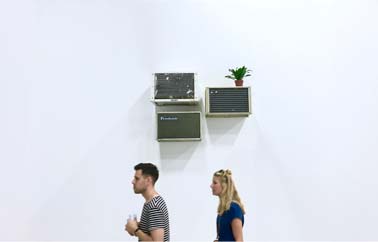Mika Rottenberg’s work, The AC Trio, 2016 displayed at the Palais de Tokyo’s summer exhibition, Happy Sapien, inverts her viewer’s daily relationship to air conditioning by displaying the back end of three units inside the gallery space. By installing what most air conditioner users would consider to be the uglier side of their units which usually hang out of windows and always leak, Rottenberg isolates the grotesque aesthetics of the appliance by removing its usual function. With a small planter sitting atop the third unit in the trio, Rottenberg pokes fun at a meager attempt at integrating flora into the street-side of urban life. Below Rottenberg’s trio sit two pans atop hotplates and another plant. The filthy drip that every city dweller has experienced falls onto the pans that cook our food and the plants that hydrate our earth. The viewer may even begin to imagine the heat of the hotplates rising up into the units. By appealing to her viewer on a visceral level, calling to mind the use of daily objects and the flow of liquid, sound, and heat between them, Rottenberg begins to create an aesthetic of that which is omnipresent and yet invisible, air.
Ceiling Fan Composition #2, 2016, another of Rottenberg’s works displayed in Happy Sapien, is comprised of the colorful and vibrant display of the four fans behind the gallery wall. Like disco-balls rotating to an unseen rhythm, Rottenberg’s fans become mesmerizing, each illuminated by a different color of neon light. While the AC trio slowly drips filth, pushed out of someone’s window and spilling over into the gallery space, the fans spin together external to the gallery space in a neat composition. By encasing her fans outside of the room in which the viewer resides, Rottenberg, once again, removes their usual function. In so doing, she opens a space for the viewer to interact with air on an unusual level; aesthetically, rhythmically, and hopefully, with an eye toward the future of air.
Written by Tess Gruenberg and Francesca Michel

